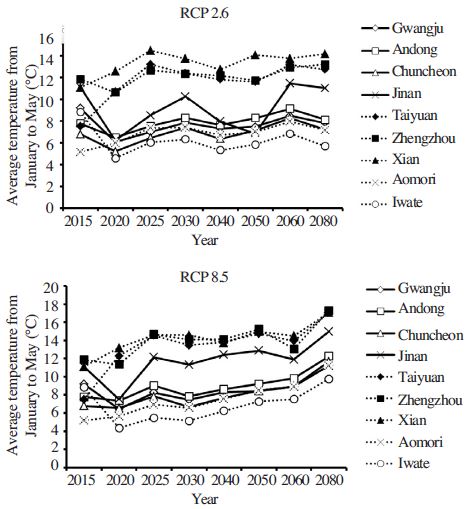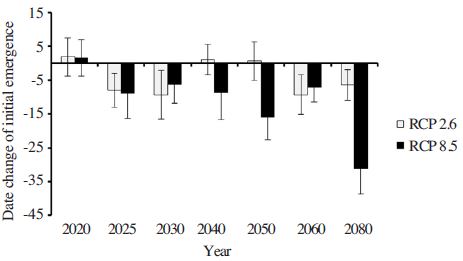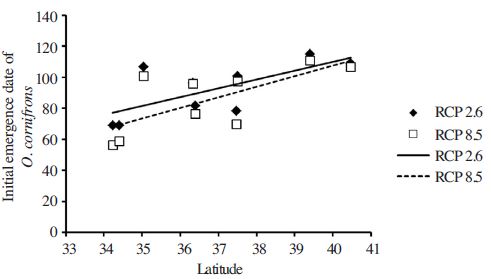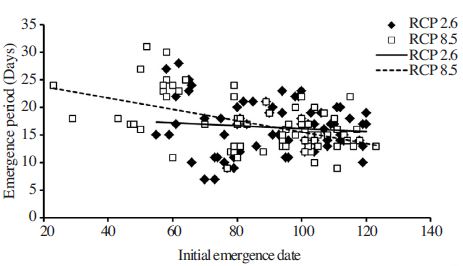
Prediction of Spring Emergence of Osmia cornifrons Radoszkowski in Korea, China and Japan under Future Climate
Abstract
The Japanese hornfaced bee, Osmia cornifrons Radoszkowski (Hymenoptera: Megachilidae), which overwinter as diapausing adult in cocoon, is an important pollinator of fruits including apple in China, Japan, Korea and United States. The synchronization of spring emergence of O. cornifrons with apple blossom is critical for successful pollination. In present study, we predicted spring emergence of O. cornifrons in Korea, China and Japan based on the degree day model using a two-parameter Weibull function under the future climate scenarios of RCP 2.6 and 8.5. The predicted initial emergence Julian dates of O. cornifrons in 2025, 2030, 2040, 2050, 2060, and 2080 were earlier 8.9, 6.3, 8.67, 16.0, 7.1, and 31.1 days, respectively under RCP 8.5 scenario than that in 2015. There was linear relationship between latitude and predicted initial emergence Julian date. Emergence period was not influenced by the initial emergence date under RCP 2.6, but it becomes longer as O. cornifrons emerge earlier under RCP 8.5 scenario. Our predictions could help to develop the pollination strategy under the climate change conditions.
Keywords:
Osmia cornifrons, Climate change, Representative Concentration Pathway, Temporal mismatchingINTRODUCTION
The Japanese hornfaced bee, Osmia cornifrons Radoszkowski (Hymenoptera: Megachilidae) is a solitary bee. Each female O. cornifrons makes her own nest, provisioning the cells for her offspring. The male hornfaced bee emerges earlier about one week than pear trees bloom in the spring. Females emerge 2 or 3 days later after emerging males, depending upon weather conditions. The size of females is larger than that of males (Yamada et al., 1971; Jeong and Jung, 2011).
Osmia cornifrons was found can be developed into an effective pollinator of sweet pepper under glasshouse conditions (Kristjansson and Rasmussen, 1990). West and McCutcheon (2009) had evaluated that O. cornifrons can be successful pollinator of commercial highbush blueberry. Moreover, O. cornifrons has been applied as pollinator in apple orchards in China, Japan, Korea and United States (Yamada et al., 1971; Xu et al., 1995; Lu et al., 2002; Lee et al., 2008; Matsumoto et al., 2008; Lee et al., 2009; Matsumoto et al., 2009; Matsumoto and Maejima, 2010).
As with most solitary bees, O. cornifrons has a short adult phase with most of the life span spent undergoing development and diapause inside nests. Thus, it is necessary to ensure that adult bees are active when their target crops are in bloom to maximize crop pollination. The spring emergence model of O. cornifrons had been developed in USA and Korea (White et al., 2009; Ahn et al., 2014). The relationship between emergence rates of O. cornifrons females and temperature was described with linear and nonlinear functions, and the spring emergence of O. cornifrons was described with a two-parameter Weibull distribution model (Ahn et al., 2014). The lower developmental threshold and the thermal constant of Korean population of O. cornifrons female were estimated to 7.98°C and 112.43DD (degree days), respectively (Ahn et al., 2014). According to the spring emergence model and the daily average temperature under future climate, we can predict the spring emergence frequency of O. cornifrons.
The Intergovernmental Panel on Climate Change (IPCC) has documented increased global temperatures, a decrease in snow and ice cover, and changed frequency and intensity of precipitation (IPCC, 2014). IPCC focus on four emissions trajectories to describe four possible climate futures, which were known as representative concentration pathways (RCPs), and have labelled them RCP2.6, 4.5, 6.0 and 8.5, based on a radiative forcing (2.6, 4.5, 6.0, and 8.5 W/m2). The most important effect of climate change on plant-pollinator interactions can be expected to result from global warming. Global warming can influence the phenology of pollinators by producing shorter diapause duration and an earlier spring emergence (Bale and Hayward 2010).
Although the spring emergence model of O. cornifrons had been developed in the previous study in Korea (Ahn et al., 2014), the effect of climate change on the spring emergence was not clear. Therefore, the objective of this study was to predict the spring emergence of O. cornifrons under RCP 2.6 and 8.5 scenarios in Korea, China and Japan, and discover the effect of climate change on the predicted spring emergence of O. cornifrons.
MATERIALS AND METHODS
Study sites and climate data
In total, 9 main apple production sites from Korea (Gwangju, Andong and Chuncheon), China (Jinan, Taiyuan, Zhengzhou and Xian) and Japan (Aomori and Iwate) were selected (Table 1). These 9 sites were representative major apple production areas from Korea, China and Japan, which need pollination service in apple orchards. Daily temperature data in these sites from January to May in 2020, 2025, 2030, 2040, 2050, 2060, and 2080 based on RCP 2.6 and 8.5 scenarios were obtained from the Meteorological Administration (KMA) and Climate Change Information Center (CCIC). Daily temperature data from January to May in 2015 were collected from websites (www.climate.go.kr and www.accuweather.com).
DD model and emergence distribution model
The equation 1 was applied to calculate the cumulative degree-days. The lower developmental threshold (7.98°C) and the thermal constant (112.43 DD) estimated by Ahn et al. (2014) were applied to equation 1 and 2.
| Eq.1 |
Where DD is daily DDs, Ta is daily average temperature, and T0 is the lower developmental threshold.
Cumulative emergence frequency of O. cornifrons adults was analyzed using two-parameter Weibull function (Equation 2, Weibull, 1951).
| Eq.2 |
Where F(x) is the cumulative frequency at normalized time x, a is the scale parameter and b is the parameter of curve shape. Normalized time x was calculated by dividing the cumulative DDs by thermal constant. The values of a and b calculated by Ahn et al. (2014) were applied (a=1.0219, b=3.3601).
The date of 10% cumulative emergence estimated by the model was assumed as the initial emergence date of O. cornifrons. The emergence period of O. cornifrons was calculated by the days between 10% and 90% cumulative emergence distribution.

The average temperature from January to May in different years in 9 sites under RCP 2.6 and 8.5 scenarios.

Date change of initial emergence based on RCP 2.6 and 8.5 scenarios compared with 2015. Initial emergence date means the date of 10% emergence.

The relationship between latitude and predicted initial emergence date of Osmia cornifrons under future climate (RCP 2.6 and 8.5). The initial emergence date were the mean values of 8 years (2015, 2020, 2025, 2030, 2040, 2050, 2060 and 2080).
Statistical analysis
Date was expressed as Julian date which is the number of days from January 1. Predicted initial emergence date changes of different years were compared with ANOVA, the data from 9 sites in different year were assumed as 9 replications. Regression analyses of latitude and initial emergence date, and initial emergence dates and emergence periods were conducted suing SAS 9.2 package.
RESULTS
The average temperature change under future climate
Fig.1 showed the average temperature from January to May in different years in 9 sites under RCP 2.6 and 8.5 scenarios. The spring emergence model of O. cornifrons was built based on the cumulative degree-days, which was related to the temperature change from January to May. The predicted average temperature in Korea, China and Japan increase 3.79, 6.2 and 3.48°C, respectively, from 2015 to 2080 under RCP 8.5 scenario, while which did not change much under RCP 2.6 scenario.
Predicted emergence frequency under future climate
The emergence frequencies of O. cornifrons in 9 cities under RCP 2.6 and 8.5 scenarios were predicted using the distribution emergence model (Table 2 and Table 3). Compared to 2015, the predicted initial emergence date changes of O. cornifrons in 2020, 2025, 2030, 2040, 2050, 2060, and 2080 were significant different under RCP 2.6 (ANOVA, df=62, F=36.3, P<0.0001) and 8.5 scenarios (ANOVA, df=62, F=39.04, P<0.0001) (Fig. 2). The initial emergence dates in 2025, 2030, 2040, 2050, 2060, and 2080 were predicted to occur 8.9±7.4, 6.3±5.6, 8.7±8.0, 16.0±6.7, 7.1±4.3, and 31.1±7.6 days earlier than that in 2015, respectively, under RCP 8.5 scenario (Table 3).
The relationship between latitude and initial emergence date
There was linear relationship between latitude and predicted initial emergence date of O. cornifrons under future climate (Fig. 3). Initial emergence occurred later in the sites with higher latitude; y=5.67x-116.9 (df=8, R2=0.48, P=0.0385) and y=6.81x-164.77 (df=8, R2=0.50, P=0.0335) under RCP 2.6 and 8.5 scenarios, respectively.
The relationship between initial emergence date and emergence period
The linear relationship between predicted initial emergence date and emergence period of O. cornifrons was only significant under RCP 8.5 even though with lower determinant power (Fig. 4). As O. cornifrons emerge earlier, the emergence period will become longer; y= -0.027x+18.852(df=71, R2=0.01, P=0.3707) under RCP 2.6 and y=-0.1028x-25.844(R2=0.25, P<0.0001) under 8.5 scenario.
DISCUSSION
When plants and pollinators respond differently to climate variation, phenological mismatch may occur. Several studies have detected different phenological sensitivities to a warming climate between plants and insects (Gordo and Sanz, 2005; Parmesan, 2007; Forrest and Thomson, 2011; Kudo and Ida, 2013). The phonological date of apple full blooming was reported to become earlier by 1.0-2.3 days per decade in Japan (Sugiura et al., 2013). Fujisawa and Kobayashi (2010) found that apple flowering date was closely correlated to the mean air temperature throughout March and April and the flowing date responded to the long-term climate change at -3.8°C-1 in northern Japan. According to these researches and the climate change scenario of RCP 8.5 in Aomori, the flowering date was predicted to become about 15 days earlier in 2080 than that in 2015. While the 50% cumulative emergence date of O. cornifrons become 25 days earlier from 2015 to 2080 (Table 3). Thus, the mismatch between phenology of O. cornifrons and apple blooming maybe happen under the future climate condition.
In present study, the predicted emergence dates of O. cornifrons in Korea, China and Japan showed earlier as the temperature increase under future climate. Our predictions could help to develop the planned pollination strategy under the climate change conditions. Based on the finding of our study, temporal mismatches between wild population of O. cornifrons and apple blossom would be predicted. The population of O. cornifrons were collected and stored under cold temperature, controlling the time of release them could match their emergence with apple blooming and alleviate the pollinator deficits. To accurately predict and monitor the impact of climate change on crop pollination, further studies such as effect of climate change on the mortality of pollinators, the shift of pollinator distribution range, and on co-occurrence of plant and pollinator species in space may be required.
Acknowledgments
SG was supported by the BK 21 plus program of Andong National University from Ministry of Education, Korea. This research was partly supported from Climate change and Insect phenology research project (PJ010851), RDA.
LITERATURE CITED
-
Ahn, J. J., Park, Y. L., and Park, C., (2014), Modeling spring emergence of Osmia cornifrons Radoszkowski (Hymenoptera: Megachilidae) females in Korea, Journal of Asia-Pacific Entomology, 17(3), p901-905.
[https://doi.org/10.1016/j.aspen.2014.10.002]

-
Bale, J. S., and Hayward, SAL., (2010), Insect overwintering in a changing climate, The Journal of experimental biology, 213, p980-994.
[https://doi.org/10.1242/jeb.037911]

-
Forrest, J. R. K., and Thomson, J. D., (2011), An examination of synchrony between insect emergence and flowering in Rocky Mountain meadows, Ecological Monographs, 81, p469-491.
[https://doi.org/10.1890/10-1885.1]

-
Fujisawa, M., and Kobayashi, K., (2010), Apple (Malus pumila var. domestica) phenology is advancing due to rising air temperature in northern Japan, Global Change Biology, 16(10), p2651-2660.
[https://doi.org/10.1111/j.1365-2486.2009.02126.x]

-
Gordo, O., and Sanz, J. J., (2005), Phenology and climate change: a longterm study in a Mediterranean locality, Oecologia, 146, p484-495.
[https://doi.org/10.1007/s00442-005-0240-z]

- IPCC, (2014), Climate change 2014: Synthesis Report. SPM 1.1 Observed changes in the climate change system, Available from URL: http://www.ipcc.ch.
- Jeong, S. A., and Jung, C., (2011), Effect of temperature and relative humidity on the emergence of overwintered Osmia cornifrons (Hymenoptera: Megachilidae), Korean Journal of Apiculture, 26, p261-266.
- Kristjansson, K., and Rasmussen, K., (1990), Pollination of sweet pepper (Capsicum annuum L.) with the solitary bee Osmia cornifrons (Radoszkowski), In VI International Symposium on Pollination, 288, p173-179.
-
Kudo, G., and Ida, T., (2013), Early onset of spring increases the phenological mismatch between plants and pollinators, Ecology, 94, p2311-2320.
[https://doi.org/10.1890/12-2003.1]

- Lee, S. B., Lee, K. Y., Yoon, H. J., Park, I. G., Park, H. R., Ha, N. G., and Kim, S. R., (2009), Characteristics and effects on pollinating activity according to the release numbers of Osmia cornifrons and O. pedicornis at the apple orchards, Korean Journal of Apiculture, 24, p219-226.
- Lee, S. B., Seo, D. K., Choi, K. H., Lee, S. W., Yoon, H. J., Park, H. C., and Lee, Y. D., (2008), The visited insects on apple flowers, and the characteristics on pollinating activity of pollinators released for pollination of apple orchards, Korean Journal of Apiculture, 23, p275-282.
- Lu, L., Meng, Y., and Jin, D., (2002), Characteristics of Osmia cornifrons and O. longnicornis in an apple-pear orchard, Kunchong zhishi/[Zhongguo kun chong xue hui], 40(1), p71-74.
-
Makoto, K., Kajimoto, T., Koyama, L., Kudo, G., Shibata, H., Yanai, Y., and Cornelissen, J. H. C., (2014), Winter climate change in plant-soil systems: summary of recent findings and future perspectives, Ecological research, 29(4), p593-606.
[https://doi.org/10.1007/s11284-013-1115-0]

- Matsumoto, S., and Maejima, T., (2010), Several new aspects of the foraging behavior of Osmia cornifrons in an apple orchard, Psyche: A Journal of Entomology, 2010, p1-6.
-
Matsumoto, S., Abe, A., and Maejima, T., (2009), Foraging behavior of Osmia cornifrons in an apple orchard, Scientia horticulturae, 121, p73-79.
[https://doi.org/10.1016/j.scienta.2009.01.003]

-
Matsumoto, S., Eguchi, T., Maejima, T., and Komatsu, H., (2008), Effect of distance from early flowering pollinizers ‘Maypole’ and ‘Dolgo’ on ‘Fiji’ fruit set, Scientia horticulturae, 117, p151-159.
[https://doi.org/10.1016/j.scienta.2008.03.025]

-
Parmesan, C., (2007), Influences of species, latitudes and methodologies on estimates of phenological response to global warming, Global Change Biology, 13(9), p1860-1872.
[https://doi.org/10.1111/j.1365-2486.2007.01404.x]

-
Sugiura, T., Ogawa, H., Fukuda, N., and Moriguchi, T., (2013), Changes in the taste and textural attributes of apples in response to climate change, Scientific reports 3.
[https://doi.org/10.1038/srep02418]

- Weibull, W., (1951), A statistical distribution functions with wide applicability, Journal of applied mechanics, 18, p293-297.
-
West, T.P., and McCutcheon, T.W., (2009), Evaluating Osmia cornifrons as pollinators of highbush blueberry, International Journal of Fruit Science, 9(2), p115-125.
[https://doi.org/10.1080/15538360902991303]

-
White, J., Son, Y., and Park, Y. L., (2009), Temperature-dependent emergence of Osmia cornifrons (Hymenoptera: Megachilidae) adults, Journal of economic entomology, 102(6), p2026-2032.
[https://doi.org/10.1603/029.102.0602]

- Xu, H. L., Yang, L. L., and Kwon, Y. J., (1995), Current status on the utilization of Osmia bees (Hymenoptera: Megachilidae) as pollinators of fruit trees in China, Korean Journal of Apiculture, 10, p111-116.
- Yamada, M., N. Oyama, N. Sekiga, S. Shirasaki, and C. Tsugawa, (1971), The ecology of megachillid bee, Osmia cornifrons Radoszkowski (Hymenoptera: Apidae) and its utilization for apple pollination, Bull. Aomori Apple Experiment Station, No. 15.

